|
 |
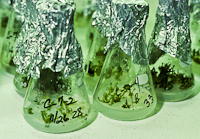 Tissue culture (TC) is a term
for a form of high-tech plant cuttings. Instead of
making a 3 inch long cutting of a plant stem and
sticking it in potting soil or
perlite to form one new
plant, tissue culture involves taking a very small piece
of a plant and turning it into thousands of new plants. Tissue culture (TC) is a term
for a form of high-tech plant cuttings. Instead of
making a 3 inch long cutting of a plant stem and
sticking it in potting soil or
perlite to form one new
plant, tissue culture involves taking a very small piece
of a plant and turning it into thousands of new plants.
The difference between TC
and regular cuttings is that this space age procedure
must be done under totally sterile conditions. This
makes it very costly since it requires laboratory type
equipment and specialized techniques. Therefore, TC is
generally used to multiply plants that are very
difficult to propagate with other more low-tech methods.
Or, it may be used to very rapidly reproduce high value
plants where large numbers are in demand.
The TC Process - The following is a general description
of the tissue culture process which may vary somewhat
from lab to lab.
-
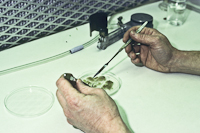 A part of the mother
plant (called the explant) is placed in a sterilizing
solution in order to kill any fungal spores that
might be on its surface. A part of the mother
plant (called the explant) is placed in a sterilizing
solution in order to kill any fungal spores that
might be on its surface.
-
Using a cutting
instrument such as a scalpel which has been
sterilized in a flame, a very small piece of a root,
leaf, stem or bud is cut from the sterile explant
tissue.
-
This piece is placed
in a test tube which contains a sterile mixture of
organic matter called agar that is meant to act as
nutrients. Also included with be one or more plant
hormones to stimulate the process further. These
mixtures can become quite exotic and each TC lab
will develop its own favorite mix that works best
for them.
-
The tubes are placed
in a sterile, growing chamber with artificial light
and climate control.
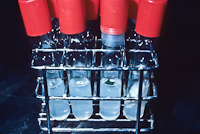
-
Eventually, the tiny
cutting begins to multiply on the growing medium. It
is then taken out, cut into even more pieces and
returned to the sterile environment. This may be
done several times as the tiny plantlets continue to
multiply.
-
At the final stage in
the laboratory, hormones are introduced to the
system to encourage the development of roots.
-
Once root systems
appear on the plants, they are then transferred into
trays and moved to the greenhouse for growing on to
saleable size.
|
|
Why Go to the Trouble and
Expense? |
-
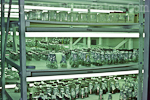 Clone Productions - Since the resulting plants
are actually all exact replicates of the original
plant, TC is a way to maintain the precise
characteristics of the original explant. Clone Productions - Since the resulting plants
are actually all exact replicates of the original
plant, TC is a way to maintain the precise
characteristics of the original explant.
-
Difficult to Propagate Plants - TC may be a last
resort option for some plants that do not easily
propagate through standard cuttings, seeds,
layering, grafting or other methods.
-
 Fast Production - Plants reproduced through TC
can be rapidly multiplied and made available for
sale. This is especially useful for plants with high
demand which can still maintain a decent price
level. From a small piece of a plant, a good lab can
turn out thousands of clones in a few short months. Fast Production - Plants reproduced through TC
can be rapidly multiplied and made available for
sale. This is especially useful for plants with high
demand which can still maintain a decent price
level. From a small piece of a plant, a good lab can
turn out thousands of clones in a few short months.
-
Disease Free Plants - Because it is done under
highly controlled, sterile conditions, TC may often
be used to produce certified, disease resistant
clones. By using specific techniques, virus infected
plants may sometimes be propagated with the
resulting clones being virus free.
-
Sports - Because a variety of growth
hormones
are routinely used in TC, there is a higher than
usual likelihood that mutations or "sports" will be
created. In species such as
Hosta, many new
cultivars have been discovered mixed in with the
extremely large number of clones produced.
|
|
Why Not Use TC All the Time? |
-
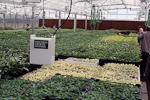 Expense - This is space age tech stuff and
requires a high level of investment in equipment and
highly trained staff. Therefore, it is not
economically viable for every nursery. It is usually
better to propagate a plant by some of the older,
low-tech methods which do a good job at a much lower
cost. Expense - This is space age tech stuff and
requires a high level of investment in equipment and
highly trained staff. Therefore, it is not
economically viable for every nursery. It is usually
better to propagate a plant by some of the older,
low-tech methods which do a good job at a much lower
cost.
-
Sports - While this can be an advantage with
certain species, it can also be a negative when too
many sports occur. Also, with trees and shrubs, it
may be years before the sporting (such as a change
in fruit color) may be discovered. This factor is
another cost consideration since plants must be
inspected closely at all steps to assure quality.
-
Sanitation - The specter of fungal infections
ruining an entire environmentally controlled room
full of test tubes hangs heavily over the head of
every TC lab. Extensive efforts must be made to take
care in every step of the process to prevent
contamination.
|
|
For more on tissue culture as it relates to
hostas... |
|



